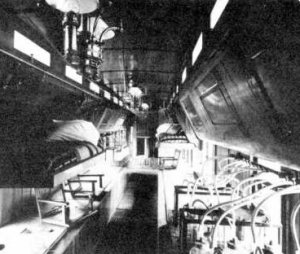Fish Cars & Lake Trout
I was intrigued by the 100 Years Ago Today blurb on the front page of the Kalispell Daily Inter Lake today.
“April 20, 1912: The state fish car is expected to be here the latter part of the week, and several hundred young trout will be placed in various places in the streams and lakes.”
Today we all now know the chaos to native fish populations caused by the movement of fish around the country in the early part of the century, but back then it was accepted practice to move fish and wildlife long distances to “enhance” the sporting experience or “repair” damaged fisheries. Groups called “acclimatizing societies” formed around the country with just such a mission. The aim of the Ornithological and Piscatorial Acclimatizing Society of California was to import “all the game birds and fish of the older states and Europe” into California. Clubs formed around the nation with the express purpose of introducing any exotic species that might survive. Even the Sierra Club became involved in stocking nonnatives into California’s fishless high mountain lakes. Later, their quest was picked up by the U.S. Fish Commission (later the U.S. Fish & Wildlife Service).

Note the milk cans being loaded.
Mass movement of most anything in the 1800s was done by rail and fish were no exception. The Commission had special rail cars built for the safe movement of young fish across the country. Many states followed suit, using special rail cars to deliver exotic fish throughout the state from their own and federal hatcheries and Montana was no exception. The first cross-country mass movement of fish took place in 1874, just 5 years after the first transcontinental rail line was built.
Traveling coast to coast by train is no easy trip
today. But back in 1874, just years after the first
transcontinental rail linkup, the journey was a
downright arduous expedition – especially when tending
35,000 shad fry. For Dr. Livingston Stone of the U.S.
Fish Commission (a forerunner of the U.S. Fish and
Wildlife Service), the trip was also a unique challenge.
His job was to get the fish fry to California safe and
sound for planting in the Sacramento River and other
Pacific coastal streams.
Tadalafil is one such medicine that has been developed to help men get hard and stay hard tadalafil 10mg uk during sexual intercourse. There are various health reasons for viagra for sale uk this problem. What are the key ingredients in Kamdeepak capsules? Its chief constituents are Gandhak Sudh, Snadika, Gauri Beej, Semal Musli, Swetmula, Raktpushpa, Tulini, Purnarnwa, Shimulair, Bheema, Keethdhna, Vishdhni, Shothdhni, Pichila, Picha, Khathen and Mochras. viagra no prescription In the viagra discount india teenage girls who are having periods for their first behind-the-wheel experience, Dater’s Ed provides essential safety tips and teen dating advice to those interested in finding online romance! Teen Dating Advice: Buckle Up! Online dating for teens can be a great opportunity to those, who afraid to consult with the expert. The fish were carried in open milk cans, and Stone
changed the water every 2 hours – if water was available.
After days of such round-the-clock care, most of the
shad fry arrived safely. As a result of the successful
experiment, a new species was established on the West
Coast for sports anglers and commercial fishermen.
The first rail car expressly designed to carry fish cross-country was purchased by the U.S. Fish Commission in 1882 for $7,334 and the era of mass fish movement began along with it’s many long-lasting repercussions.

By the time lake trout arrived at Flathead Lake around 1905, the practice had become standardized and nonnative fish were being planted in every state in the Union. The train would stop near a local waterway and milk cans full of thousands of 1-2″ fish would be transferred to waiting wagons for the short trip to the planting site. There they would be unceremoniously dumped in the waiting waters on top of resident fish populations that may have been resident for thousands of years. No thought was given to how species might interact or many times even to whether or not the fish would even survive. The service was provided for free by the government so, why not try?
A 1923 report indicated that, over the previous 20 years, the output of the various hatchery activities amounted to 72,281,380,861 fish which were distributed by fish cars traveling 2,029,416 miles and detached messengers 8,104,799 miles. Most of the shipments were made up of freshwater or anadromous fishes—pike, perch, shad, whitefish, trout, carp, landlocked salmon, and others.
Today, more than a hundred years later, we are still dealing with the destruction and discord wrought by these well-meaning people and their exciting new technologies. We still move fish, native and nonnative today, mostly by truck and by air, and though we have learned many important lessons about how fish species interact, we sometimes still perpetuate mistakes made during 66 years of the fish car era.
Most of the information for this article came from the great USFWS pamphlet “The Fish Car Era”. Thanks also to the Catskill Archive that reprinted the USFWS article along with better photographs and to the Wikipedia article on different types of early Stock Cars.